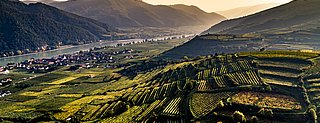
Kollmitz
Facts:
- Town:
- Joching
- Size in ha:
- 23,76
- Altitude in m:
- 236 - 363
- Aspect:
- SE
- Average Slope in %:
- 27
- Max. Slope in %:
- 79
- Insolation in hours per year:
- 2217
- Terraced vineyard:
- Yes
- Distance to Danube in m:
- 560
- Labour required in h:
- 17.800
- First documentary evidence:
- 1303
Winery
-

Domäne Wachau
Dürnstein -

Weingut Eigl
Joching, Wösendorf -

Weinhofmeisterei Mathias Hirtzberger
Wösendorf -

Weingut Höllmüller
Joching -

Weingut Holzapfel
Joching -

Weingut Josef Jamek
Joching -

Weingut Machherndl
Wösendorf -

Weingut Miesbauer
Joching -

Weingut Franz Pichler
-

Weingut Schmelz
Joching-Weißenkirchen, Joching
Description
The Kollmitz vineyard can be considered the landmark mountain of the town of Joching. It is dominated by escarpment terraces. The name probably has the same origin as the neighbouring mountain Kollmütz in Wösendorf.
Soil Profile Kollmitz - Paragneis with carbonate
Kollmitz is the name of the hill above Joching, visible from afar. Much of it is covered either by loess, terrace gravel or sea sediments. Yet this profile shows a paragneiss core. Paragneisses, unlike Gföhl gneiss, are diverse in appearance and almost always differ from one vineyard to the next. Just below the Kollmitz “high plateau”, white bands become apparent in the soil profile. These secondary carbonate precipitates probably originate from the former loess cover. During gradual weathering, the carbonate was leached out and later precipitated in the fissures. Exposed at the crest of the hill, the loess cover has long since eroded away here but is still intact farther below. The Kollmitz has a geological diversity and differing degrees of exposure, thus rendering wines that vary widely in style.
Soil Profile Kollmitz - Paragneis weathered
This profile from Kollmitz represents the area near the crest and the adjacent vineyards to the north. The parent material originates from a prehistoric landslide during the transition from the Chattian to the Aquitanian age (20–26 million years ago), a strongly weathered crystalline rock consisting of metamorphic paragneiss. The conglomerate is brecciated, so that the paragneiss layers can no longer be recognised. This structure allows the vine roots to penetrate the rock even more deeply.

